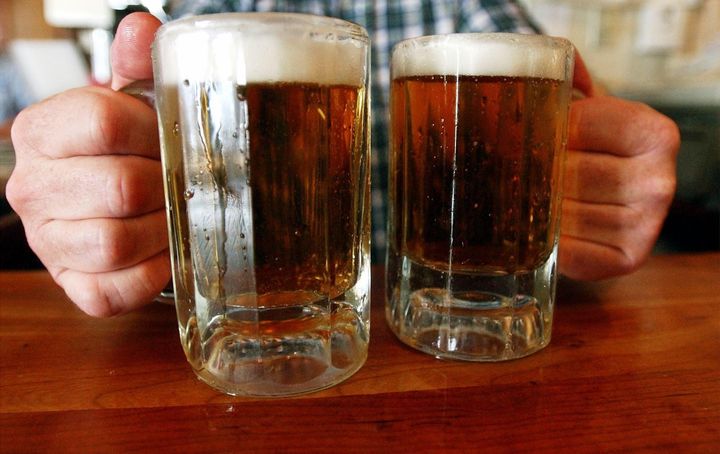
By David K. Randall
Feb 3 (Reuters) - Beer and football: it's one of those perfect combinations, like peanut butter and chocolate.
Super Bowl Sunday is the eighth-largest day for beer sales in the United States, according to the Nielsen Co. Most of the estimated 49.3 million cases sold will be consumed at home or a living room party, not at a bar.
That large in-home audience for American football's annual championship game this Sunday is part of the reason the broadcast has long been prime real estate for beer commercials featuring everything from talking frogs to glass bottles playing quarterback.
But investors shouldn't be fooled by the clever advertising from big-time beer makers touting brands like Coors Light and Budweiser. Those names might be dominant on the airwaves, but space in the refrigerator is increasingly going to specialty beers.
The U.S. beer market is in the midst of a transition. Smaller, craft brewers are taking market share from global giants like Anheuser Busch InBev, which has a 47 percent share of the U.S. beer market. These smaller companies target discerning, and often affluent, customers who are the foodies of the beer world.
The message is resonating. While sales of traditional names have fallen by as much as 2 percent since 2009, revenue in the craft brew segment has grown by double-digits, according to Beer Marketer's Insights, a trade publication.
How to play a shifting beer market.
GO SMALL, BUT HEDGE
Craft brewers are a concentrated bet on higher-end U.S. consumers. The majority of their sales come from the domestic market.
Typical buyers of craft beers are frequently Whole Foods customers. Concerned more with quality than convenience, they are willing to pay more for what they believe is a superior product. They tend to be older than 30, employed as professionals and earn higher-than-average salaries. The core audience for traditional products distributed by global beer companies, meanwhile, is 21 to 30 year old men, a demographic that has been hit harder by unemployment since the recession ended in 2009.
Though prices differ by region, craft brews tend to be more expensive than bigger brands. A six-pack of Coors Light bottles goes for just under $7 in the New York area; a similar pack of seasonal Sam Adams for about $9.
Boston Beer Company, the brewer behind Sam Adams, is the most efficient option for tapping into the craft brewery trend. It is the biggest small company in the marketplace, with a share of about 1 percent of the total U.S. beer market.
Analysts like Boston Beer in part because it is small, but growing at a time that customer tastes are changing. "Consumers have been willing to try and embrace new and interesting beverages and change long-held daily habits," noted Marc Riddick, an analyst at Williams Capital Group, in a Jan. 30 report. Riddick rates the company an outperform.
Still, it is more expensive than the average stock, trading at 23 times earnings. The broad Standard & Poor's 500 index trades at about 13 times earnings. And shares are down about 5 percent since the start of the year, on investor concern about the effect of high commodity costs on the company's margins. Barley cost pressures are estimated to add more than $8 million in incremental cost, according to the company.
Investors can hedge a bet on Boston Beer by picking up a commodity-focused fund that would benefit from a jump in barley prices. The $427 million Elements Rodgers International Commodity Agriculture ETN (RJA), for instance, holds futures contracts for some 22 products, including wheat, barley and oats. The fund charges 75 cents per every $100 invested.
The Craft Brew Alliance, a smaller brewing company in the Pacific Northwest, is another bet. It has less than 0.6 of the total beer market, analysts said, but could be a takeover target for a larger company looking to expand its reach.
PLAYING DEFENSE
Global brewers are also taking steps to go smaller.
Anheuser Busch InBev, for instance, purchased Chicago's Fulton Street Brewery last year for $38 million and will continue to distribute its popular 312 Urban Wheat Ale. Molson Coors Brewing and SABMiller, meanwhile, signed a joint venture in 2007 called MillerCoors. One of its divisions, called Tenth and Blake, markets and sells craft brands. Tenth and Blake's sales increased by 17.2 percent in its last quarter, driven by increased sales of Blue Moon and Leinenkugel's.
"These mega beer companies really depend on the success of their brands like Coors Light and Bud Light," said Thomas Mullarkey, an analyst at Morningstar who covers the beer industry. "But they want success at the craft level too. By buying small, they can put their tremendous distribution networks to work and add to their competitive advantage."
Larger brewers also offer another benefit: dividends. Anheuser Busch InBev, trades at a P/E of 20 and has a dividend yield of 1.7 percent. SABMiller trades at a P/E of 23, with a dividend yield of 2.4 percent. Diageo, parent of Guinness and several liquor brands, has a 3.14 percent dividend yield.
Only a few funds offer specialized bets on the beer market. The $82 million Vice Fund offers perhaps the best alternative, though it comes with a hefty price tag of $1.81 per every $100 invested. The fund concentrates its bets on so-called sinful markets of alcohol, tobacco, gambling and weapons manufacturers.
Diageo, SABMiller and Carlsberg are among its top holdings. The fund is up an annualized 0.5 percent over the five years, slightly more than the 0.1 percent return of the S&P 500 over the same time. (Reporting By David Randall; Editing by Jennifer Merritt and Steve Orlofsky)
Copyright 2011 Thomson Reuters. Click for Restrictions.
